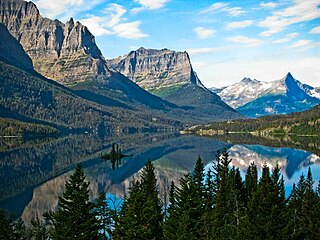Module 4: North America
Section outline
-

Glacier National Park, by Dave Sizer licensed CC-BY 2.0
The realm of North America as a continent extends from the polar regions of the Arctic in northern Canada and Alaska all the way south through Mexico and the countries of Central America. Geographers usually study the continent by dividing it into two separate realms based on differences in physical and cultural geography. The United States and Canada share similar physical geography characteristics as well as a common development history with either a British or French colonial legacy. Mexico and Central America are dominated by more tropical climates and were colonized mainly by the Spanish. The United States and Canada—the second- and third-largest countries in the world in physical area, respectively—make up more than 13 percent of the world’s total landmass. The Atlantic Ocean borders their eastern edge, and the Pacific Ocean creates their western boundary. To the north is the Arctic Ocean. The North American region is highly urbanized—about 80 percent of the population lives in cities—but other vast areas, especially in Canada, are sparsely populated. Although some natives remain, most of North America’s diverse population consists of immigrants or descendants of immigrants from other world regions. The United States is the world’s largest economy, and both countries enjoy high standards of living as technologically developed countries.
Upon completion of this module, you will be able to:- Define the physiographic regions of North America. (CLO 1 & 3)
- Explain the two dominant climate patterns in North America. (CLO 3 & 5)
- Find out which three European countries had the most significant early influence on North America, what parts of the region they dominated, and what their long-term impacts have been. (CLO 4 & 5)
- Determine the population distribution of the United States and Canada. (CLO 2, 4, & 5)
- Explain which economic patterns helped the United States become the world’s largest economy, Canada's key economic sectors, and the connections between the U.S. and Canadian economies. (CLO 4 & 5)
- Explain the concepts of the cultural melting pot and the American Dream and how they have contributed to American society and culture and been exported globally. (CLO 4 & 6)
- Explain how physical geography has contributed to economic activities. (CLO 3, 4, & 5)
To achieve these objectives:
- Read the Module 4 Introduction
- Read Chapter #4 -North America in World Regional Geography: People, Places, and Globalization
- Complete the Module 4 Assignment, Discussion Board Posts (3), Chapter Quiz, and H5P activities
Module Pressbooks Resources and Activities
You will find the following resources and activities in this module at the Pressbooks website. Click on the links below to access or complete each item.
*-
-
Instructions
This assignment addresses course outcomes 4 & 5 and module learning objective 3.
Write a 250-word essay in response to the following prompt. The essay must be submitted as a Microsoft Word (docx) file and must have 1-inch margins, use double spacing throughout its length, and use Times New Roman font.
Choose one of the three European countries that had the most significant impact on North America and describe which region or regions it affected the most, providing two specific examples of long-term effects on the region(s).
- Define the physiographic regions of North America. (CLO 1 & 3)
Background Colour
Font Face
Font Kerning
Font Size
Image Visibility
Letter Spacing
Line Height
Link Highlight
Text Colour
